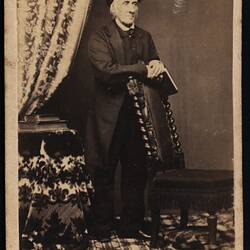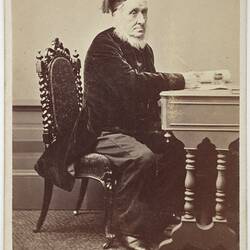Summary
Carte de Visite portrait photograph of John Pascoe Fawkner, taken by Paterson Brothers, Melbourne, on 28 May 1862, with hand-written inscriptions on the reverse apparently by Fawkner himself. Of particular significance is that he uses the carte de visite to record key events in his life:
Born October 20th - 1792 at London
Left England April 25 - 1803
Landed at Port Phillip Oct 19th - 1803
Left it Jan 15
Settled at Hobart Town Feb 16th - 1804
Married my present wife Nov 1818 at Hobart Town
Founded Melbourne Aug 29th 1835
Photograph taken May 29th - 1862
[signed] John Pascoe Fawkner M.L.C.
Fawkner is traditionally credited as being one of the co-founders of Melbourne, alongside John Batman, in 1835, although the two men were rivals. He held passionate and contradictory beliefs. He was a teetotaller, yet established Melbourne's first hotel on the southern side of what was then the Market Square, now the site of the present-day Immigration Museum.
He was also the proprietor of Melbourne's first newspaper, The Melbourne Advertiser, which commenced in 1838 and marked an important milestone for the fledgling township. Fawkner's printing press with which he produced the Advertiser was identified and exhibited at the 1866 Intercolonial Exhibition held in Melbourne, and subsequently became one of the earliest collection items of the Industrial and Technological Museum when it was founded in 1870. It is now held in the collections of Museum Victoria.
He was charged more than once with assault and could be underhand in his business dealings, yet he was elected to Victoria's first parliament. For more than 30 years Fawkner made his mark on Melbourne. When he died, a crowd of 15,000 watched his funeral procession of over 200 carriages. The outer-northern Melbourne suburb is named after him.
In the 19th century, cartes de visite were a very popular as calling cards. They had a definite format, which was an international standard. Small albumen photographic prints were mounted on cards 2.5 by 4 inches. They were used for decades around the world. Unlike earlier photographs made with such processes as the daguerreotype and ambrotype, cartes de visite could be sent through the mail without the need for a bulky case and fragile cover-glass.
Description of Content
A carte-de-visite photographic portrait of John Pascoe Fawkner, showing Fawkner posed standing behind a chair with his hand resting on the chair back, holding a book. A side table with two books on top is position to his right, with a heavily draped curtin falling behind it. Fawkner wears a dark coloured beret and a three-quarter length frock coat.
Physical Description
Sepia-coloured photographe adherred to card carte de visite with inscriptions in pen on the reverse.
More Information
-
Collecting Areas
-
Acquisition Information
Donation from Margaret L. Malseed, Sep 2011
-
Person Depicted
Mr. John P. Fawkner, Melbourne, Victoria, Australia, 28 May 1862
-
Format
Photograph, Sepia
-
Inscriptions
Inscribed, back, pen: Born October 20th - 1792 at London./ Left England April 25 - 1803 landed at/ Port Phillip Oct 19th - 1803. Left it Jan 15;/ and settled at Hobart Town Feb 16th - 1804./ Married my present wife Nov 1818 at/ Hobart Town/ Founded Melbourne Aug 29th 1835/ Photograph taken May 29th - 1862/ John Pascoe Fawkner M.L.C.
-
Classification
-
Category
-
Discipline
-
Type of item
-
Image Dimensions - Photograph
62 mm (Width), 100 mm (Height)
-
Keywords




